Movie Review
 |
 |
 |
 |
 |
 |
 |
Problems with Disney's Coco - Part 3
Paganism Dominates Coco's Mexican Feast Day
After giving an overview of the film Coco (here) as well as the history of Mexico's initiation into the Faith (here), we move on to list some of the problematic pagan aspects of Día de los Muertos, or All Souls Day, November 2.
Since the movie Coco preaches a return to the pagan elements of Día de los Muertos, we will point out some of them to help Catholics to understand why they should be rejected.
Animist food offerings
Food offerings are common to most major pagan religions, used in the worship of deities but also ancestor worship:
“Sacred foods played an important role in the annual ritual ceremonies that the Aztecs celebrated. The Aztecs petitioned the gods of the earth and the rain to continue providing the people with food by offering back to them those very same foods. Sometimes the offerings were elaborate dishes, while at other times the food would be made into special offerings to give to the gods.”
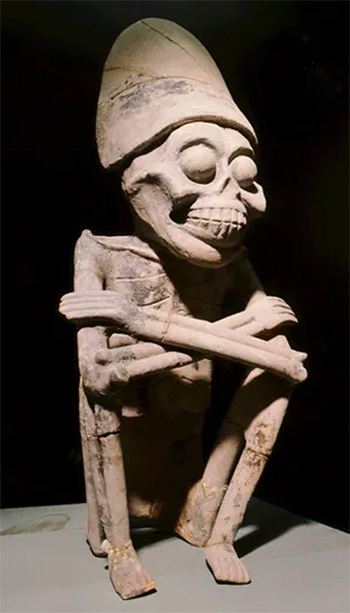
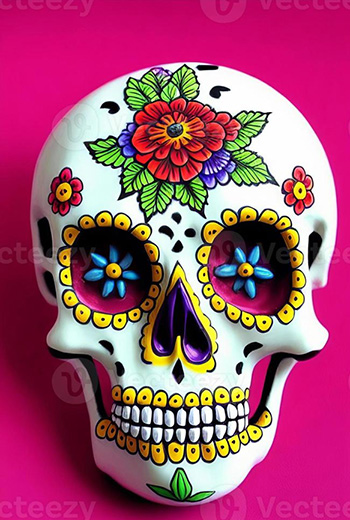 Aztec deity Mictlantecuhtli
Aztec deity Mictlantecuhtli
The prevalence of skulls in Día de los Muertos seems to us to be a tendential imbalance in the proper Catholic understanding of death. On the surface, much like the newer devilish costumes of Halloween, this exaggerated quantity of skulls and skeletons encourages a taste for horror and the macabre instead of reminding Catholics of the Four Last Things, its proper aim.
One could surmise from further research that the exaggerated quantity of skulls in today's Día de los Muertos encourages a revival of the cult to the Aztec deity Mictlantecuhtli.
In Aztec pagan mythology, Mictlantecuhtli is the skeleton-masked god of death who resided in the ninth hell of Mictlan, his abode. All the dead, except warriors who died in battle and women who died giving birth to their first child, would travel there on a four-year trek, and then they would disappear altogether. Offerings were made to the dead 80 days after the funeral, then each year for four years. After that, all links between the dead and the living was severed. (Encyclopedia Britannica)
As many Mexicans may note, even the sculpture of this deity is reminiscent of the skull designs popular in the Día de los Muertos.
The exaggeration of skulls also appears to encourage a cult to La Santa Muerte, which is the main deity of the syncretic voodoo religion Santeria, also present in many parts of Mexico. La Santa Muerte is normally pictured looking like Our Lady of Guadalupe, with the figure of Our Lady replaced by a devilish looking skeleton. We decided to not include an image of this deity out of respect for Our Lady.
The custom of the painting of faces and bodies to appear as skeletons seems irreparably pagan, as does the popularity of figures like La Calavera Catrina, a skeletal Dia de los Muertos feminine icon. In our opinion, the popular sugar skulls today seem to tend along this same spirit.
Catholicizing pagan customs
 In Mexico, the Catholic Church took the tradition of making ofrendas and the pagan beliefs about ancestors that were presented in this film, kept the beauty of the traditions and transformed the feast day into one of praying for the dead and making sacrifices for them. Gradually she removed even remnants of paganism, as was her wise way of acting in the past.
In Mexico, the Catholic Church took the tradition of making ofrendas and the pagan beliefs about ancestors that were presented in this film, kept the beauty of the traditions and transformed the feast day into one of praying for the dead and making sacrifices for them. Gradually she removed even remnants of paganism, as was her wise way of acting in the past.
However, as explained earlier, due to Masonry and the Revolution acting against the complete Catholicizing of Mexico, some pagan tendencies and beliefs came back.
Today they are making a strong return, as people are rejecting the Church; the progressivist Church is even going so far as to apologize for the “conquest” of Mexico and “imposing” the good customs of Christian Civilization to replace the pagan elements.
Syncretism, once prohibited is now permitted and growing in Mexico due to the "inculturationn" of the Conciliar Church.
Keeping the good aspects
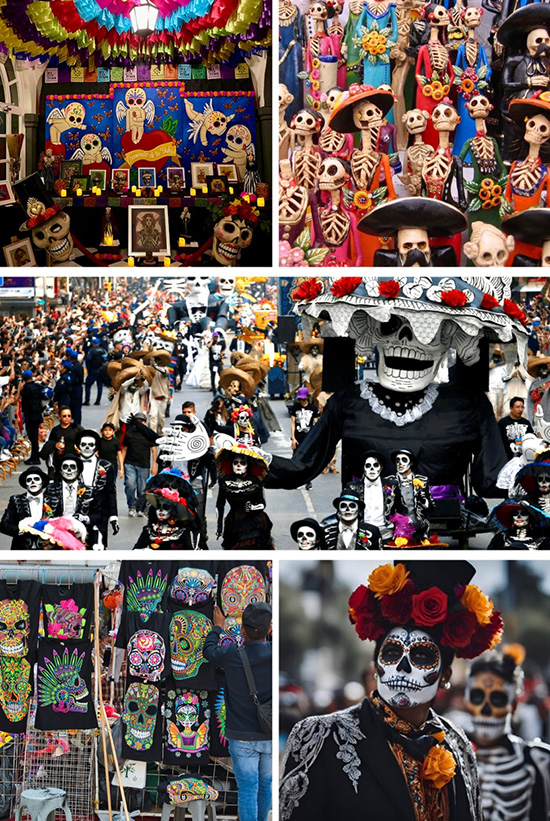 We have today a mix: Certain pagan customs were stripped of pagan connotations and given a new Catholic meaning, such as the offerings of food, candles, and marigolds to ancestors. Food offerings, once very pagan, can be used to adorn ofrendas and then be given to the poor as alms. Candles were blessed and burned as a sacramental to relieve poor souls in Purgatory.
We have today a mix: Certain pagan customs were stripped of pagan connotations and given a new Catholic meaning, such as the offerings of food, candles, and marigolds to ancestors. Food offerings, once very pagan, can be used to adorn ofrendas and then be given to the poor as alms. Candles were blessed and burned as a sacramental to relieve poor souls in Purgatory.
As we can see, there are some nice traditions that had pagan origins and were properly Catholicized. The decoration of graves and ofrendas with marigolds, candles, photos of ancestors, food which can be given to the poor and skulls that remind one of the reality of death (when used in due proportion & not to excess) can be beautiful ways to honor ancestors and to encourage us to pray for them and make sacrifices for them.
Conclusion
In conclusion, we recommend parents not to show the movie Coco to their children. We also recommend the reclaiming of good Dia de los Muertos traditions and a gradual purging of pagan tendencies. Families could retain their ofrendas but Catholicize them. The dead can be visited and prayed for. Masses can be said for them, and holy water sprinkled on their graves, and blessed candles lit for them.
May Our Lady of Guadalupe bless this effort to reclaim Dia de los Muertos, which has a distinctly Mexican color, charm and flavor.
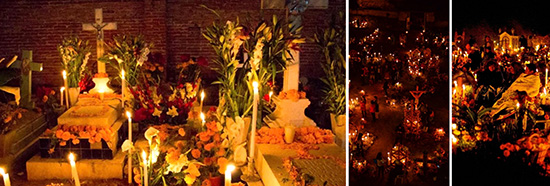

Since the movie Coco preaches a return to the pagan elements of Día de los Muertos, we will point out some of them to help Catholics to understand why they should be rejected.
Animist food offerings
Food offerings are common to most major pagan religions, used in the worship of deities but also ancestor worship:
- The
ancient Egyptians made offerings of food, drink, clothing & ointment to deities and ancestors;
- The Hindu ritual of the shraddha involves offering food to ancestors;
- The Shinto ritual of the shinsen involves offering food and drink in order to gain the blessings of deities;
- The Afro-indigenous voodoo religion of Candomblé (also known as
Macumba) popular in Brazil is infamous for making food offerings of yellow corn to its gods and ancestors;
- The Afro-Caribbean religion of Santería also employs
offering of foods such as fruit and liquor to its deities and ancestors;
- Buddhism has its own ancestor worship ritual that also includes offering food to gain merit for the deceased person.
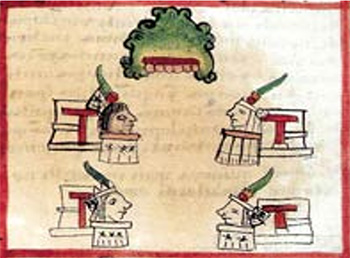
Dough figures made for an Aztec festival; Primeros Memoriales (Sahagún), here.
“Sacred foods played an important role in the annual ritual ceremonies that the Aztecs celebrated. The Aztecs petitioned the gods of the earth and the rain to continue providing the people with food by offering back to them those very same foods. Sometimes the offerings were elaborate dishes, while at other times the food would be made into special offerings to give to the gods.”

Above: The skull-headed deity Mictlantecuhtli; below: a typical skull of Día de los Muertos

The prevalence of skulls in Día de los Muertos seems to us to be a tendential imbalance in the proper Catholic understanding of death. On the surface, much like the newer devilish costumes of Halloween, this exaggerated quantity of skulls and skeletons encourages a taste for horror and the macabre instead of reminding Catholics of the Four Last Things, its proper aim.
One could surmise from further research that the exaggerated quantity of skulls in today's Día de los Muertos encourages a revival of the cult to the Aztec deity Mictlantecuhtli.
In Aztec pagan mythology, Mictlantecuhtli is the skeleton-masked god of death who resided in the ninth hell of Mictlan, his abode. All the dead, except warriors who died in battle and women who died giving birth to their first child, would travel there on a four-year trek, and then they would disappear altogether. Offerings were made to the dead 80 days after the funeral, then each year for four years. After that, all links between the dead and the living was severed. (Encyclopedia Britannica)
As many Mexicans may note, even the sculpture of this deity is reminiscent of the skull designs popular in the Día de los Muertos.
The exaggeration of skulls also appears to encourage a cult to La Santa Muerte, which is the main deity of the syncretic voodoo religion Santeria, also present in many parts of Mexico. La Santa Muerte is normally pictured looking like Our Lady of Guadalupe, with the figure of Our Lady replaced by a devilish looking skeleton. We decided to not include an image of this deity out of respect for Our Lady.
The custom of the painting of faces and bodies to appear as skeletons seems irreparably pagan, as does the popularity of figures like La Calavera Catrina, a skeletal Dia de los Muertos feminine icon. In our opinion, the popular sugar skulls today seem to tend along this same spirit.
Catholicizing pagan customs

Top: La Catrina; bottom, its painting by artist Diego Rivera
However, as explained earlier, due to Masonry and the Revolution acting against the complete Catholicizing of Mexico, some pagan tendencies and beliefs came back.
Today they are making a strong return, as people are rejecting the Church; the progressivist Church is even going so far as to apologize for the “conquest” of Mexico and “imposing” the good customs of Christian Civilization to replace the pagan elements.
Syncretism, once prohibited is now permitted and growing in Mexico due to the "inculturationn" of the Conciliar Church.
Keeping the good aspects

Top left, an ofrenda with skeletons & sugar skulls; right, street decorations; center & bottom right, parades with macabre costumes; bottom left, t-shirts sold in Mexico City
As we can see, there are some nice traditions that had pagan origins and were properly Catholicized. The decoration of graves and ofrendas with marigolds, candles, photos of ancestors, food which can be given to the poor and skulls that remind one of the reality of death (when used in due proportion & not to excess) can be beautiful ways to honor ancestors and to encourage us to pray for them and make sacrifices for them.
Conclusion
In conclusion, we recommend parents not to show the movie Coco to their children. We also recommend the reclaiming of good Dia de los Muertos traditions and a gradual purging of pagan tendencies. Families could retain their ofrendas but Catholicize them. The dead can be visited and prayed for. Masses can be said for them, and holy water sprinkled on their graves, and blessed candles lit for them.
May Our Lady of Guadalupe bless this effort to reclaim Dia de los Muertos, which has a distinctly Mexican color, charm and flavor.

Cemetery decorations on the night of Día de los Muertos are filled with candles and marigolds, much like the sea of lights of Polish All Souls Day

Posted October 30, 2024
______________________
______________________





